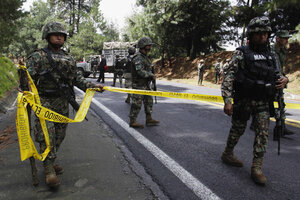Questions after Mexican police open fire on US officials
Members of the Mexican Federal Police opened fire on a US diplomatic car on Friday. Was it mistaken identity or an assassination attempt?

Mexican marines cordon off the site where an armored US embassy SUV was attacked on a road near the town of Tres Marias, on the outskirts of Cuernavaca August 24. Two US police instructors were accidentally shot and wounded by Mexican police early on Friday after being mistaken for criminals, a Mexican government security official said.
Margarito Perez/Reuters
Mexico City
An attack by members of the Mexican federal police on a US diplomatic vehicle has sparked questions about a force considered critical to the fight against organized crime and may strain relations between Washington and Mexico City.
The circumstances of Friday’s shooting—which injured two unnamed US officials and a Mexican Navy captain—remain foggy. Experts say what is clear is that Mexican federal police sprayed gunfire at an SUV with diplomatic plates.
“What happened shouldn’t have happened,” says Juan Salgado, a professor of judicial studies at CIDE, a Mexico City-based research center. “This shows there is an important question about the (management) of the federal police.”
President Felipe Calderón has made the federal police a centerpiece of the fight against organized crime in Mexico, boosting the force to more than 36,000 members from 6,000 six years ago. The force, which receives training from the US as part of the $1.6 billion Merida Initiative, is intended to be more professional, with tighter controls on its behavior and better vetting of recruits than the regular police.
That's all intended to increase competence and decrease corruption in a police force that's been waging a losing battle against organized crime, largely driven by the drug trade, for years. Yet the shooting of the US diplomatic vehicle and a June 25 shootout between federal police at Mexico City’s international airport suggest the chain of command is broken, Mr. Salgado says.
“The procedures (set up by the reform) are good in theory,” he says. “But at an institutional level, they aren’t being followed.”
Cocaine cop
In the June incident, three federal policemen were killed by fellow officers believed to be trafficking cocaine from South America through the Mexico City International Airport. The federal police recently reassigned all 348 officers working security in the airport to posts in different states.
The Mexican government has detained a dozen federal police officers in the US Embassy vehicle shooting. The US Embassy said in a statement Friday that the two US government personnel and Mexican Navy captain “were ambushed by a group of individuals,” adding that the “Government of Mexico has acknowledged that members of the Federal Police were involved and fired on the U.S. Embassy vehicle.”
The Mexican government said federal police were chasing criminals in the area, suggesting the shooting could have been a case of mistaken identity.
Or was the attack intentional, police working in cahoots with criminals? Analysts point out that the Mexican Navy, employing US intelligence, killed cartel kingpin Arturo Beltran Leyva in December 2009.
“It’s illogical to think that they (the federal police) can’t identify a diplomatic car,” says Raul Benitez Manaut, a professor with the National Autonomous University of Mexico who focuses on security and the armed forces. “This is going to be a heavy hit on the confidence the (U.S.) Embassy has toward the federal police.”
Both the Mexican and US governments have said they are cooperating in the investigation.
“Was there a motive to attack them and the Navy together?” Mr. Benitez Manaut asks. “The most important thing is to demand there be no impunity.”
Other attacks on US officials
There have been two previous attacks on US officials in Mexico in the past two years. Gunmen killed one US federal agent and wounded another in 2011, believing the agents to be rivals, authorities have said. In 2010, in another case of mistaken identity, a worker at the US consulate in Ciudad Juárez and her husband were shot to death.
Fred Burton, a Stratfor security analyst and former State Department investigator, questions an apparent lack of “command and control” in the Mexican federal police.
“This is basic police work 101: You have to have a predicate to shoot,” he says. “You’ve clearly got the fog of the cartel wars where the police are responding to an event and simply light up everybody involved. There doesn’t appear to be any disciplined fire or command and control.”
President Felipe Calderón often repeats Mexico’s need for a disciplined, trustworthy police force.
“How will Mexico recover its security if the police don’t function,” he asked in speech earlier this year at a police academy. “That’s why we have to rebuild the police.”
The reconstruction has been ongoing. The question remains what kind of police force will emerge.

